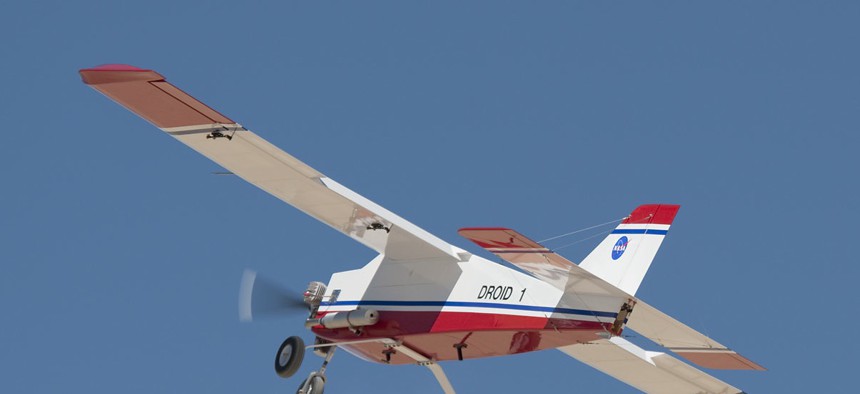Commentary: How Drones Can Help

NASA uses drones in some of its programs. NASA
Unmanned but not unpiloted, UAVs offer benefits that are waiting for policy to catch up.
Privacy concerns, integration into the national airspace and spectrum allocation are the big three obstacles to wider deployment of unmanned aerial vehicle technologies. Like any new technology that develops faster than the speed of policy, lawmakers, lawyers and others grappling with these issues should not allow them to curtail the benefits of UAVs.
Who would have thought in the 1950s that room-size computers would spawn new areas of law and new questions around intellectual property and warfare? Finding creative ways to manage equally innovative UAV technologies involves similar hurdles. Innovative technologists and business leaders had the vision to harness the benefits of computers, while taking on the contemporary issues they raised. We are in the middle of doing the same with UAVs.
Unmanned but not unpiloted, UAVs are commonly referred to as “drones,” which implies the absence of an intelligent human operator. In fact, satellite and ground control stations feed a large amount of data to remote UAV pilots to inform their decisions. As is widely reported, the U.S. military uses UAVs in theater now and has been successfully using them for decades.
The public knows less about civilian uses of UAV technology. The Aerospace Industries Association released a report recently to address the perceptions and potential of UAVs. They noted that domestic applications are predicted to include search and rescue, law enforcement, weather forecasting, border patrol, firefighting, disaster response, precision farming, commercial fisheries, scientific research, aerial photography, mail delivery, communications relay, infrastructure monitoring and emergency management.
The corresponding benefits are more accurate weather forecasts, safer streets, bumper crops, fewer Americans engaged in dangerous jobs, more dangerous fugitives apprehended and reduced risk to firefighters.
Benefits to society result not just from UAV platform technology, but the sensors they carry – sensors that can be applied to saving lives after a natural disaster; providing situational awareness during wildfires; capturing real time information about the impact of oil spills; and protecting the security of our border by identifying the trafficking of weapons or drugs. These are but a few of the applications drones have to positively affect society on a global level.
Two recent nationwide surveys indicate widespread public support of UAVs.
A Duke University survey found 57 percent of the public supports their use for any application and an even higher percentage support specific applications, including search and rescue operations (88 percent). Also, 74 percent of those polled by the Christian Science Monitor said they support nonmilitary domestic use of UAVs provided individual privacy concerns and ground safety issues are met.
In June during a Senate Judiciary Committee hearing, FBI Director Robert Mueller admitted the FBI has used unmanned aerial systems for U.S. domestic surveillance. In a follow-up letter responding to a query from Sen. Rand Paul, the FBI said the agency uses UAVs in limited circumstances when there is a specific operational need.
The letter goes on to outline several rules and regulations the FBI follows when using UAVs, including obtaining Federal Aviation Administration approval. Each UAV surveillance request also undergoes the scrutiny of FBI legal counsel to ensure there are no Fourth Amendment or privacy concerns prior to senior FBI leaders approving. In cases where there is an expectation of privacy, the agency must also obtain a search warrant. So far, according to the letter, none have been needed.
Most of the letter’s content defensively centers around the process the FBI follows when using drones. It also spends three sentences on the reasons why it has used them: for surveillance to support missions related to kidnappings, search and rescue operations, drug interdictions and fugitive investigations. This is where the UAV debate should center, on finding ways to exploit the potential of UAVs while safeguarding civil liberties.
Just this past July, the FAA certified the first two U.S. UAVs for restricted use in commercial airspace, pending airworthiness certification. The FAA has been willing to work with industry, including my company, to develop the infrastructure and technology needed to ensure safe and efficient adaptation from military to commercial use in the national airspace system. And it is also willing to establish a vision that will serve the needs of all stakeholders, while ensuring the safety of our airspace.
We must build on this progress. Under Congressional stewardship, a commission comprised of technologists, legal and FAA representatives and stakeholder beneficiaries should study and recommend how we leverage the benefits of UAVs while addressing the big three obstacles.
UAV technology is ready and the needs exist. We are at the convergence of innovative UAV platforms of all sizes and capabilities, with sensor and computing technologies that will enable us to meet the needs of many markets. There is public support. What we need now is a path forward.
Sreekanth Danny Rajan is with Exelis Geospatial Systems in Herndon, Va., where he leads a portfolio that includes airborne intelligence, surveillance and reconnaissance solutions.
NEXT STORY: 4 goals for fiscal 2014





